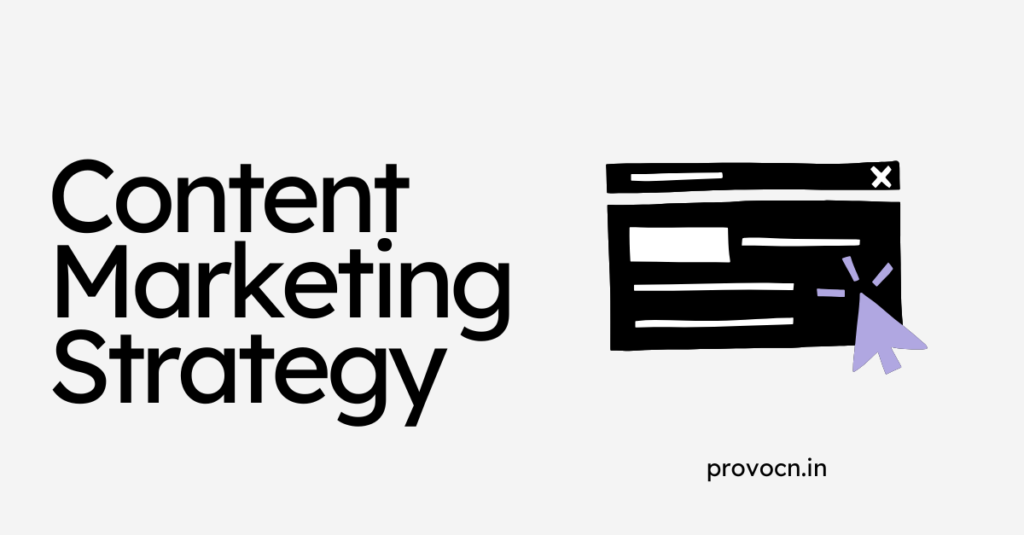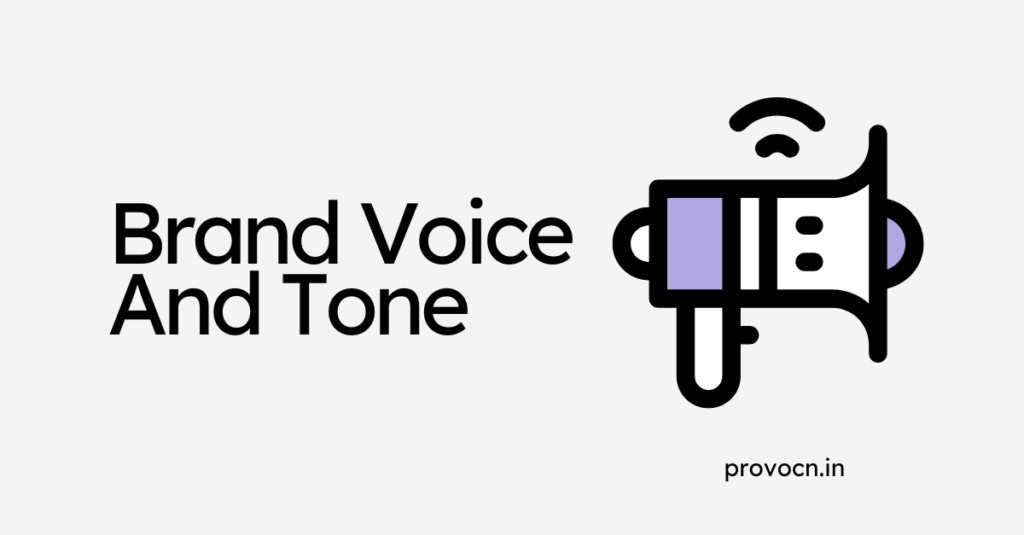Brand Identity: The Complete Guide
Published on November 23, 2024 by Anisha Patel
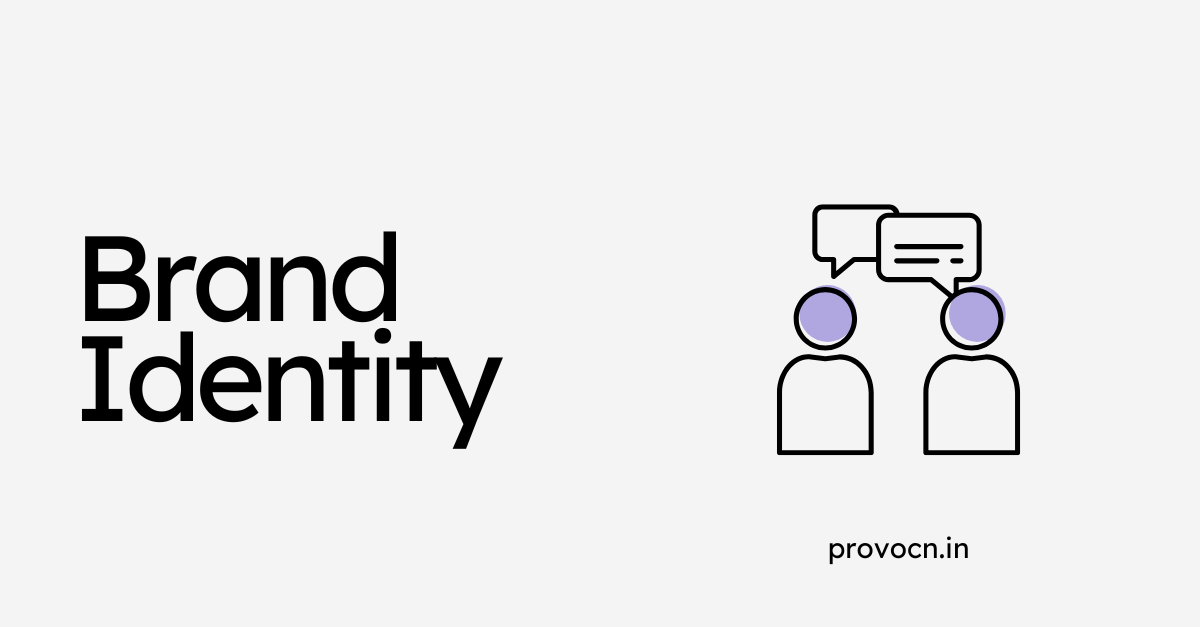
Brand identity is more than just a logo or a catchy tagline. It is the essence of your brand. It makes your brand unique and recognizable and helps you gain trust and credibility.
In today’s competitive marketplace, a strong brand identity is a must. A well-defined brand identity not only sets you apart from your competitors but also resonates with your target audience, earning their loyalty and trust.
As consumers are bombarded with countless choices, a compelling brand identity helps you carve out a distinct space in their minds. A place that belongs only to you.
Whether you’re starting a new venture or looking to refresh your existing brand, understanding and refining your brand identity is the key to long-term growth and recognition.
In this detailed guide, we’ll learn what brand identity is, why it’s crucial for your businesses and how you can create a successful brand identity.
- What is Brand Identity?
- Why is Brand Identity Important
- 7 Elements of Brand Identity
- How to Create an Effective Brand Identity
- STEP 1: Define Your Brand Purpose and Values
- STEP 2: Understand Your Target Audience
- STEP 3: Analyze Competitors
- STEP 4: Craft Your Brand Positioning
- STEP 5: Develop Visual Elements
- STEP 6: Establish a Tone of Voice
- STEP 7: Create Brand Guidelines
- STEP 8: Implement Across All Channels
- STEP 9: Engage with Your Audience
- STEP 10: Monitor and Evolve
- STEP 11: Stay Authentic
- Final Words
What is Brand Identity?
Brand identity is a collection of various elements that a company designs to create its desired image for the audience such as its logo, colour palette, typography, etc. All these elements come together to form a distinct personality and memorable brand presence in the market.
It is not only about how a brand looks, but how it feels and communicates with its audience. It is about the entire experience a customer has with the brand across all channels and interactions.
Some brands adopt a funny or playful personality, using humour in their messaging and campaigns to engage and entertain their audience. Some brands may embody a serious or professional persona, focusing on reliability, expertise, and trustworthiness.
The goal is to create a lasting, positive impression that differentiates the brand and builds long-term relationships with customers.
Since you’re reading this blog, I’m sure you’re familiar with the many terms related to branding that are often used interchangeably. Let’s first look at them so there is no confusion.
Brand Identity Vs. Brand Image Vs. Brand Personality
Brand identity, brand image and brand personality are often loosely used but they are different from each other. Let’s look at them.
| ASPECTS | BRAND IDENTITY | BRAND IMAGE | BRAND PERSONALITY |
|---|---|---|---|
| Definition | The collection of visual and verbal elements that a brand creates to convey its desired message and position in the market. | The perception of the brand as held by consumers based on their experiences and interactions. | The set of human characteristics attributed to a brand reflects its tone and manner of communication. |
Components | Logo, colour palette, typography, design style, messaging, values, and mission. | Customer perceptions, feelings, associations, and experiences with the brand. | The perception of the brand is held by consumers based on their experiences and interactions. |
| Focus | How the brand wants to be perceived, is a strategic creation. | How the brand is actually perceived in the market is often influenced by marketing and customer experience. | The character and style of the brand’s communication and interactions. |
| Control | Controlled by the brand through marketing and design efforts. | Influenced by consumer experiences, feedback, and external perceptions. | Relatively consistent but can evolve with changing consumer expectations. |
Purpose | To establish a distinct presence and identity in the market. | To understand consumer perceptions and adjust strategies accordingly. | To create an emotional connection and build a relationship with audience. |
| Examples | Nike’s adventurous and empowering personality encourages individuals to push their limits. | Nike’s swoosh logo, their tagline Just Do It, and their use of bold colours defines it. | Nike’s swoosh logo, their tagline Just Do It, and their use of bold colours define it. |
Why is Brand Identity Important
Brand identity is important for many reasons. Let’s look at some.
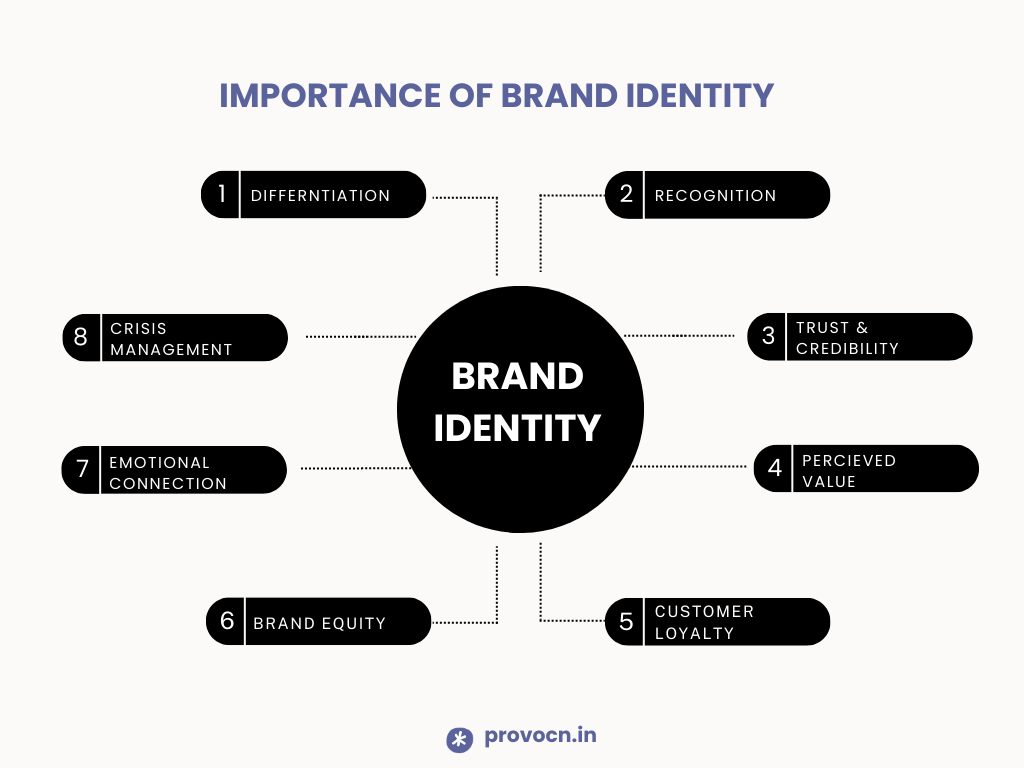
1. Differentiation
No matter what industry you operate in, the marketplace is crowded. Brand identity helps you stand out from competitors. It gives me an extra edge. Your unique visual and messaging elements will make your brand easily recognizable.
2. Recognition
Consistent brand identity creates recognition. When consumers consistently see the same logo, colours, and messaging, they are more likely to remember the brand, making them more likely to choose it when making purchasing decisions.
3. Trust and Credibility
A well-defined brand identity communicates professionalism and reliability. Consumers are more likely to trust a brand that presents a trustworthy and credible image, leading to increased customer loyalty.
4. Perceived Value
A strong brand identity can enhance the perceived value of products or services. Consumers may be willing to pay a premium for a brand they recognize and trust, leading to increased profitability.
5. Customer Loyalty
When consumers identify with a brand’s identity—its values, personality, and mission—they are more likely to become repeat customers. A strong brand identity fosters long-term relationships and customer loyalty.
6. Brand Equity
A clear and positive brand identity contributes to brand equity, which is the value derived from consumer perceptions of the brand. High brand equity can lead to increased market share and competitive advantage.
7. Emotional Connection
A strong brand identity can evoke emotions and create connections with consumers. By reflecting the values and personality of the target audience, brands can foster loyalty and advocacy.
8. Crisis Management
A well-established brand identity can help a company navigate crises more effectively. When consumers have a strong emotional connection and trust in a brand, they are more likely to remain loyal during challenging times.
Brand identity is very important for establishing a brand’s presence, building relationships with consumers, and driving business success. It shapes how a brand is perceived and interacts with its audience, ultimately impacting profitability and growth.
7 Elements of Brand Identity
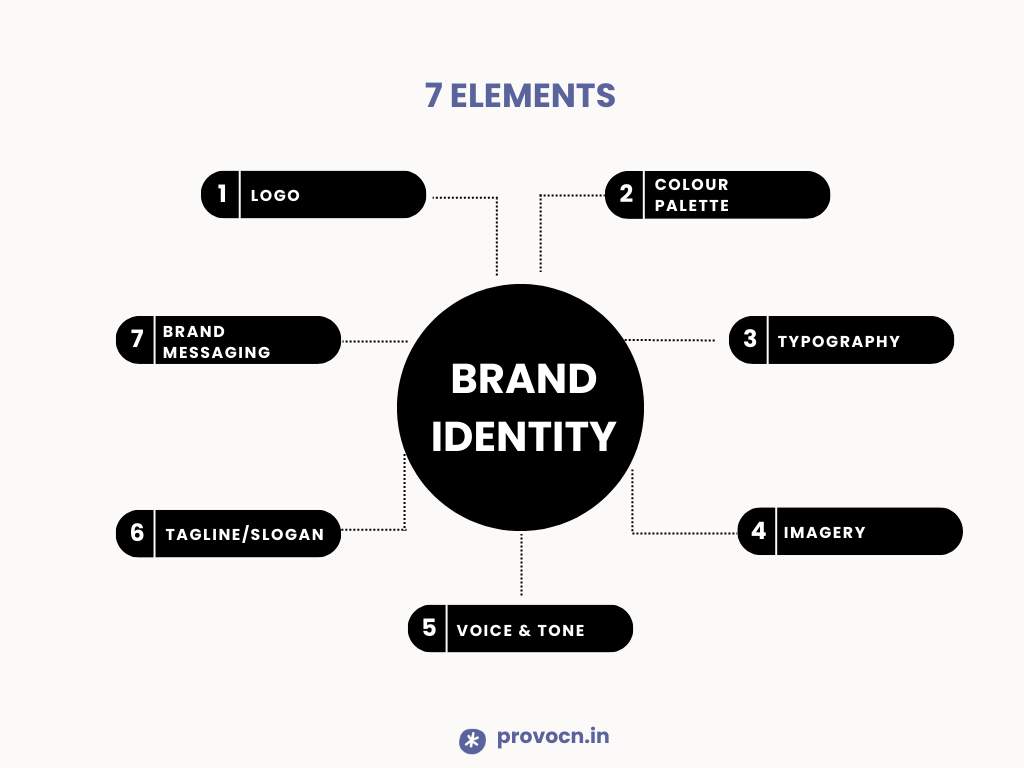
1]. Logo:
The logo is the most recognizable element of a brand identity. It serves as the visual symbol of the brand, encapsulating its essence in a simple, memorable image or text.
2]. Colour Palette:
The colour palette is a set of colours that represent the brand. These colours are used consistently across all brand materials to evoke specific emotions and create visual harmony.
3]. Typography:
Typography refers to the fonts used in all brand communications. The choice of fonts, including their size, weight, and style, helps convey the brand’s personality and tone.
4]. Imagery:
Imagery includes photos, illustrations, icons, and other visual elements that a brand uses. Consistent imagery helps create a cohesive brand experience and reinforces the brand’s message.
5]. Voice and Tone:
The brand’s voice and tone define how it communicates with its audience. Voice is the overall personality of the brand’s communication, while tone can vary depending on the context.
6]. Tagline/Slogan:
A tagline or slogan is a short, memorable phrase that encapsulates the brand’s mission or value proposition. It is often used alongside the logo to reinforce the brand message.
7]. Brand Messaging:
Brand messaging refers to the key messages that the brand consistently communicates to its audience. This includes the value proposition, key differentiators, and the overall narrative that the brand wants to convey.
How to Create an Effective Brand Identity
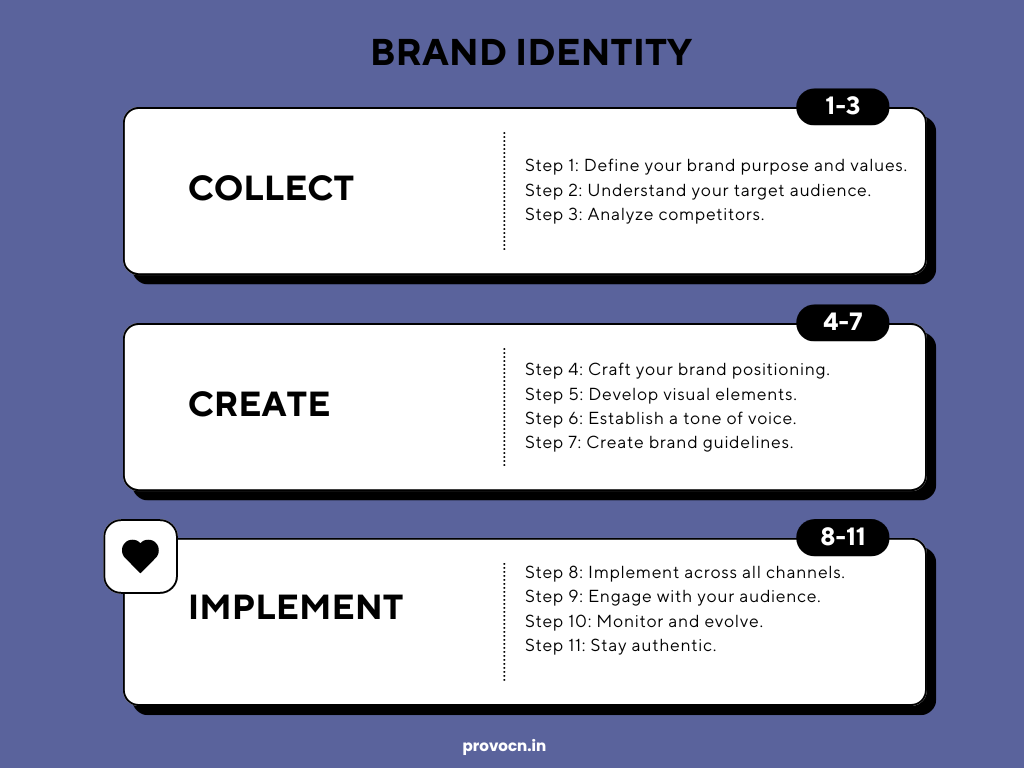
Creating an effective brand identity involves several key steps. Here’s a guide to help you establish a strong and cohesive brand identity:
STEP 1: Define Your Brand Purpose and Values
The first step in creating a good brand identity is defining your brand’s purpose. Why it exists? What problems does it solve? What motivates you to create and run this brand?
Next, you need to have a clear understanding of the challenges faced by your audience so that you can create the solutions that people are looking for.
Then, define your brand’s core values to ensure that your actions and decisions consistently align with your customers’ expectations.
Finally, focus on communication. Clearly convey your values to your target market to reflect your brand’s commitment and build trust.
STEP 2: Understand Your Target Audience
While you may already have a general idea of your audience’s challenges, it’s important to go deeper. Conduct thorough market research to identify their demographics (age, gender, location, etc.), preferences, and specific pain points.
By understanding their behaviours, needs, and desires, you can tailor your brand identity to truly resonate with them, creating a stronger connection and ensuring your solutions meet their expectations.
STEP 3: Analyze Competitors
In step 3, we’ll research about your competitors. Examine their brand identities to see how they position themselves, what appeals to their audience, and where they might fall short.
Identify successful strategies you can learn from and areas where their approach may not resonate. This analysis will help you uncover gaps or opportunities in the market, allowing you to differentiate your brand and stand out with a unique identity that offers something competitors don’t.
Now we have collected all the information. It’s time to create everything that is required to build our brand identity.
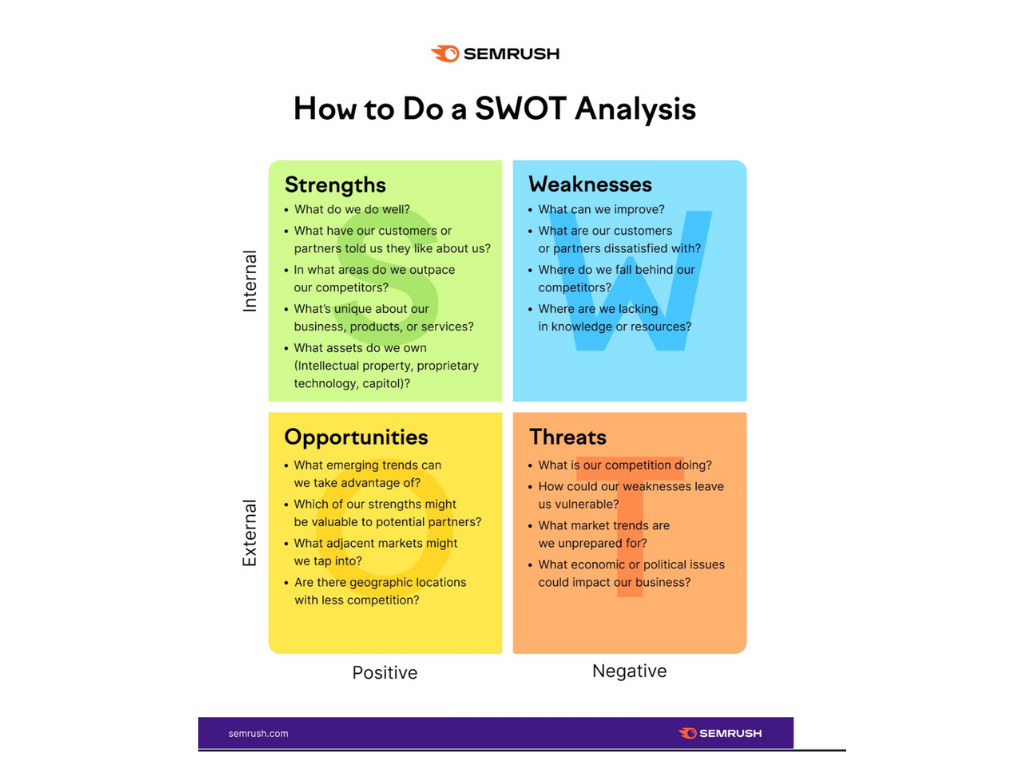
Image source: Semrush
STEP 4: Craft Your Brand Positioning
But what is brand positioning? Brand positioning is about defining how you want your brand to be perceived in the market.
Start by creating a unique selling proposition (USP) that clearly communicates what makes your brand different from competitors.
Your USP should highlight the specific benefits or values your brand offers, positioning you as the ideal choice for your target audience. By articulating what sets you apart, you establish a clear identity in the marketplace and create a compelling reason for customers to choose you over others.
STEP 5: Develop Visual Elements
It’s time for the most interesting part of brand identity, which is creating the visual elements like the logo, finalizing the colour palette, and selecting typography, and style of imagery. Your brand’s visual elements play a crucial role in how it’s perceived.

1]. Logo
Start with designing a memorable logo that embodies your brand’s identity and values, creating an instant connection with your audience. While creating a logo take care of these points:
- Memorability: Design a logo that is simple and memorable, making it easy for customers to recognize and recall your brand.
- Versatility: Ensure the logo works well in various sizes and formats, from business cards to billboards, and is effective in both colour and black and white.
- Reflective of Brand Values: The logo should encapsulate your brand’s identity and values, conveying the essence of what your business stands for.
- Timelessness: Aim for a design that can stand the test of time, avoiding overly trendy elements that may quickly become outdated.
2]. Colour Palette
Next, choose a colour palette that evokes the emotions you want your brand to convey and aligns with its personality.
- Emotional Impact: Choose colours that evoke the desired emotions and align with your brand personality, influencing how customers perceive your brand.Consistency: Use a limited colour palette consistently across all platforms and materials to create a cohesive visual identity.
- Accessibility: Consider colour combinations that are easily distinguishable for individuals with visual impairments to ensure inclusivity.
- Brand Differentiation: Select colours that help your brand stand out in the marketplace, avoiding shades that are commonly associated with competitors.
3]. Typography
Select typography that is not only legible but also complements your brand’s tone and style, whether formal, playful, or modern.
- Readability: Choose fonts that are easy to read across various mediums, ensuring that your messaging is accessible to all audiences.
- Brand Alignment: Select typefaces that reflect your brand’s personality—whether modern, classic, playful, or sophisticated—to enhance your overall identity.
- Hierarchy: Establish a clear typographic hierarchy using different font sizes and weights to guide readers through your content effectively.
- Consistency: Use a consistent set of typefaces across all materials to reinforce brand recognition and maintain a professional appearance.
4]. Style of Imagery
Lastly, define the style of imagery and graphics to be used in your marketing materials, ensuring consistency across all visuals to reinforce your brand identity.
- Consistency: Define a clear style for images and graphics that aligns with your brand identity, ensuring all visuals maintain a cohesive look.
- Authenticity: Use imagery that reflects real experiences and resonates with your target audience, showcasing genuine moments rather than overly staged scenarios.
- Diversity: Include a range of images that represent diverse perspectives and demographics, making your brand relatable to a broader audience.
- Quality: Prioritize high-quality images that convey professionalism and attention to detail, reinforcing the credibility of your brand.
STEP 6: Establish a Tone of Voice
Your brand’s tone of voice defines how you communicate with your audience and shapes their perception of your brand. Choose a tone that reflects your brand’s personality, whether it’s formal, casual, playful, or authoritative.
This tone should be consistent across all forms of communication, from marketing materials to customer service interactions, ensuring that your brand speaks in a way that resonates with your audience and strengthens your overall identity.
STEP 7: Create Brand Guidelines
Develop a comprehensive brand style guide that documents all the visual and verbal elements of your brand. This includes specific guidelines for logo usage, colour palettes, typography, imagery, and tone of voice.
The guide should also detail messaging guidelines to ensure your brand communicates consistently across all platforms and touchpoints.
By establishing clear brand guidelines, you create a unified identity that’s easily recognizable and maintains consistency as your brand grows.
STEP 8: Implement Across All Channels
Once your brand identity is defined, ensure it is consistently applied across all channels and marketing materials. This includes your website, social media profiles, packaging, advertisements, and customer communications.
Every touchpoint should reflect your visual elements, tone of voice, and overall brand messaging. Consistent implementation strengthens brand recognition and builds trust with your audience, reinforcing your identity and values across all interactions.
STEP 9: Engage with Your Audience
Building strong relationships with your audience is essential for long-term brand success. Engage with them through social media, email marketing, and other communication channels.
Encourage feedback, respond to questions, and participate in conversations to create a two-way interaction. This helps strengthen their connection to your brand, fosters loyalty, and provides valuable insights that can inform future strategies.
Consistent engagement shows your audience that you value their input and are committed to meeting their needs.
STEP 10: Monitor and Evolve
Regularly assess how your brand identity is perceived by your audience to ensure it remains effective and relevant. Collect feedback through surveys, social media interactions, and market analysis to be aware of audience sentiment and preferences.
Be open to adapting and evolving your brand identity based on this feedback, as well as changes in market trends and consumer behaviour.
This proactive approach allows you to stay aligned with your audience’s expectations and maintain a strong, resonant brand presence over time.
STEP 11: Stay Authentic
It’s crucial that your brand identity genuinely reflects the essence of your business. Authenticity builds trust and fosters a deeper connection with your audience, as they can see that your brand is true to its values and mission.
By staying authentic in your messaging, visuals, and interactions, you create a more meaningful relationship with your customers, encouraging loyalty and long-term engagement.
Always strive to maintain this authenticity as your brand evolves, ensuring it continues to resonate with your audience and aligns with their expectations.
By following these steps, you can create an effective brand identity that resonates with your target audience, stands out in the marketplace, and supports your business goals.
Final Words
A strong brand identity is an invaluable asset. Take time and create it thoughtfully. Remember that it’s not a one-time effort but an ongoing thing. Keep adapting it to stay relevant. By engaging with your audience and remaining authentic to your core values, you can cultivate lasting connections that elevate your brand above the competition.
As you continue to refine your brand identity, you’ll not only enhance your business’s visibility but also lay the foundation for sustained success and growth. Embrace the journey of building your brand identity, and watch it transform your business into a trusted and beloved name in the industry.



